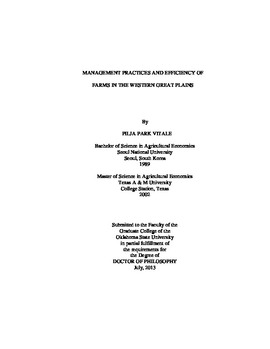| dc.contributor.advisor | Epplin, Francis M. | |
| dc.contributor.author | Vitale, Pilja Park | |
| dc.date.accessioned | 2014-09-24T14:17:10Z | |
| dc.date.available | 2014-09-24T14:17:10Z | |
| dc.date.issued | 2013-07 | |
| dc.identifier.uri | https://hdl.handle.net/11244/11050 | |
| dc.description.abstract | This dissertation is composed of four papers that have been produced as part of a research project designed to increase winter wheat productivity by suppressing cereal aphids in the Western Great Plains of the U.S. One hundred forty one farms were surveyed across six states in 2002-2005. The first paper was targeted to find the effect of crop diversity for traditional wheat dominant farms. The second paper was designed to determine if management practices such as tillage, crop diversity, wheat variety selection, and insecticide use affect wheat grain yield and net returns. Econometric methods were used to estimate wheat grain yield and net returns response to management practices. The third paper was designed to determine the relative performance of the farms as measured by technical and economic efficiency using a data envelopment analysis input oriented approach. The fourth paper was designed to compare two different methods, data envelopment analysis and stochastic frontier analysis, for measuring farm efficiency using an output oriented approach. Tobit models were used to estimate the relationships between farm efficiency and farm characteristics and management practices. | |
| dc.description.abstract | A major finding is that farms that exhibited the greatest level of flexibility in terms of crops grown, tillage systems used, and insecticide use, produced the greatest net returns per acre. Farms that have equipment enabling production with either tillage or with no-till, and farms that have the openness to use insecticide when warranted, and farms that have the flexibility to grow a variety of crops in response to agronomic and market conditions, will have the opportunity to earn more income than farms tied to the production of only wheat. Technical efficiency as measured by data envelopment analysis was found to be positively related to farm size, proportion of crop land that was cash rented, and operator education. Both efficiency estimation approaches found that the average farm in the sample operated under decreasing returns to scale and that farm size significantly affected technical efficiencies. The two approaches produced different estimates for technical efficiency scores, but gave similar results for returns to scale, and for determining factors affecting efficiency. | |
| dc.format | application/pdf | |
| dc.language | en_US | |
| dc.rights | Copyright is held by the author who has granted the Oklahoma State University Library the non-exclusive right to share this material in its institutional repository. Contact Digital Library Services at lib-dls@okstate.edu or 405-744-9161 for the permission policy on the use, reproduction or distribution of this material. | |
| dc.title | Management practices and efficiency of farms in the Western Great Plains | |
| dc.contributor.committeeMember | Brorsen, B. Wade | |
| dc.contributor.committeeMember | Giles, Kristopher | |
| dc.contributor.committeeMember | Stoecker, Arthur | |
| osu.filename | Vitale_okstate_0664D_12954.pdf | |
| osu.accesstype | Open Access | |
| dc.type.genre | Dissertation | |
| dc.type.material | Text | |
| thesis.degree.discipline | Agricultural Economics | |
| thesis.degree.grantor | Oklahoma State University | |
